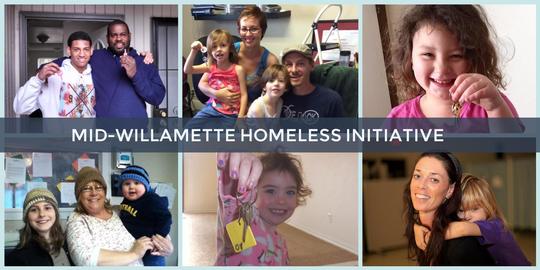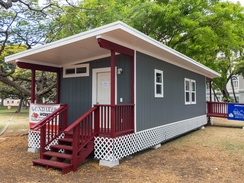
June 15, 2017
Welcome to our inaugural
edition of the Mid-Willamette Homeless Initiative e-newsletter. We will provide
regular updates to keep you informed and engaged in this important work in our
community.
You may manage your
subscription at any time by updating your subscriber preferences.
Salem Housing Rental Assistance program targets
people with highest needs
In his February State of the City address, Salem Mayor Chuck Bennett
announced the initiation of a Housing
Rental Assistance Program to provide permanent housing for Salem’s homeless
population. According to Mayor Bennett, the program is targeted toward finding housing for
the estimated 500 hard-to-house people among the city's homeless
population. "These are the homeless that we most commonly see sleeping on
sidewalks, park benches, in parks, and under bridges," Mayor Bennett said.
The initial launch of Housing Rental Assistance Program
(HRAP) includes a one-year plan to house 100 of the highest-needs homeless
individuals, using Section 8 vouchers set aside for this purpose by Salem
Housing Authority. In addition, the City of Salem is considering in its 2017-18
budget targeting $1.4 million to provide other supports, such as security
deposits, fees for identification, and credit supports. The HRAP program plans
to follow a family self-sufficiency model, equipping individuals with skills to
attain greater independence.
Salem Housing Authority will dedicate staff to HRAP and
is conducting outreach to landlords to secure units where the vouchers can be used.
According to Andy Wilch, Salem Housing Authority administrator, the partnerships
with local service providers will be the backbone
of HRAP and vital to its success.
Community Action kicks off Coordinated Entry System effort
As a part of
the evolving effort to advance homeless services in the Mid-Willamette Valley,
a new Coordinated Entry System (CES) has been launched in Marion and Polk
counties. CES is a model endorsed by HUD which involves ongoing collaboration
among regional housing and homeless service partners to strategically address
homelessness. The initial meeting was spearheaded by Jimmy Jones, Community
Resource Programs Director, Mid-Willamette Valley Community Action Agency, and
was well-attended by a number of local partners.
As explained
by Jones, CES systems are made successful by their low-barrier approach of
providing fair and equal access to housing and necessary supports. Individuals
who are homeless undergo a standardized assessment and their level of need is
quantified through a vulnerability score, which is used identify which type of
housing is most appropriate for each individual. The system of prioritization
is a shift from a traditional first come,
first served model and seeks to rapidly provide housing to those who need
it most urgently. One of the initial efforts of the CES is to partner with the
City of Salem’s new Housing Rental Assistance Program, identifying 100 of
Salem’s most vulnerable homeless persons for placement in permanent housing.

Accessory Dwelling Units increase housing supply
 Accessory Dwelling Units (ADUs) have
been used throughout the nation as a creative strategy to increase housing
supply. Several efforts have been underway at the state and local levels to
facilitate ADU construction. One such effort was Senate Bill 1024, considered
in the current legislative session, which would have allowed for ADUs to be
built on properties zoned as Rural Residential. While this bill did not move
forward, House Bill 2007, which would make it easier to build ADUs in urban
areas by limiting lengthy administrative approval processes, has been referred
to the Joint Committee on Ways and Means.
At the local level, Marion County and
the cities of Keizer and Salem have been working on ADU codes. In April, the
Salem Planning Commission recommended that the city council allow ADUs,
addressing issues such as size, height, setbacks and short-term rentals. The
commission’s recommendations can be found on the City of Salem website. Public testimony
was received at the June 12 city council meeting, where a number of people
testified in support of allowing ADUs. However, concerns around parking space requirements,
manufactured homes, and short-term rentals were highlighted by members of the
public. The issue will be discussed again on June 26, 5:30 p.m., at the Salem
Civic Center, 555 Liberty Street SE, in Salem.
The Marion County Planning Commission
has also been working on recommendations for the county to allow ADUs in
unincorporated portions of Marion County that are also within urban growth
boundaries, which would include unincorporated East Salem. The planning commission will
hold a hearing to receive testimony on August 1 at 6:30 p.m. in the Senator
Hearing Room at Courthouse Square, 555 Court Street NE, in Salem. The board
will then hold its own hearing in the fall to consider the planning
commission’s recommendations.
|
Sobering center moves forward
 After many years of planning, downtown
Salem is primed to see a new sobering center become a reality in the upcoming
months. The City of Salem is leading the effort, in collaboration with Marion
County and Salem Health. The sobering center will help to ease the burden on
law enforcement and emergency services personnel, who have limited options
outside hospital emergency departments or the county jail for persons who are
acutely intoxicated.
With the passage of House Bill 2175,
which removes the cap on the number of sobering facilities that can be
registered in Oregon, the door has been opened for such a facility in Salem.
State law allows police and emergency personnel to admit an acutely intoxicated
person to a sobering center for a 24-hour stay, where they will be safely
supervised and linked to treatment services upon discharge. State law
established by House Bill 2936 (2015) sets criteria for sobering facilities.
The facility must provide acutely intoxicated individuals with a safe, clean and supervised environment until
the individuals are no longer intoxicated. The facility also must contract with or be affiliated with an
addiction treatment program or provider for case consultation, training and
advice, and a plan for making referrals to addiction treatment. Finally, the
facility must adopt comprehensive written
policies and procedures to assure safety for the intoxicated individuals,
staff and volunteers.
When sobering centers meet these
criteria and are registered with the Oregon Health Authority, facility staff is
protected from criminal or civil liability provided that their actions are in
good faith and without gross negligence. Additionally, House Bill 2176 allows
Oregon counties to use drug and alcohol funds for sobering center operations.
|
Transition team works on implementation plans
When the Mid-Willamette Homeless
Initiative Task Force concluded its work last February, the task force
authorized a transition team to move the initiative to implementation. That
team has been meeting at the Mid-Willamette Valley Council of Governments’ offices. The focus has been to lay the foundation for
a program manager position, which will coordinate strategic plan implementation
moving forward.
Transition team participants have reviewed
an initial draft of a job description and engaged in a discussion to confirm
which organization is best equipped to house the position. Although the Council
of Governments or COG was identified early on as the likely contender, due to
its neutrality and integrated work among multiple jurisdictions, participants also
entertained the possibility of other local organizations that may be suited for
the work. Ultimately, the group agreed that the COG was uniquely suited and
most qualified to house the position.
COG President Sean O’Day will provide an
update at the June board meeting. The next step is to develop an intergovernmental
agreement among participating jurisdictions. The group has also discussed
potential candidates for a policy team that would guide the initiative’s
continued work.
For more information about the Mid-Willamette Homeless Initiative, contact: Hitesh Parekh, Marion County, at hparekh@co.marion.or.us or visit our website at www.homelesstaskforce.net.
|








